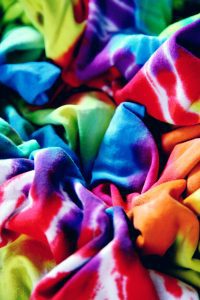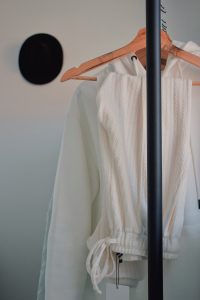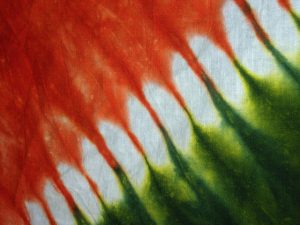How to Get Dye Out of Clothes with Vinegar?
While it may seem like a hassle removing dye from clothes can be easily removed using vinegar. Here’s how,
- Add one cup of vinegar in a tub full of water
- Let the dyed clothes soak in it for 30 minutes
- Rinse them with cold water
Read further to find a detailed step-by-step guide.
Safely Removing Clothing with Color Transit
 First of all, separate the clothes right after you notice that the dye has been transferred because the second step you intend to do is to dump in the clothes into the dryer which eventually would result in a disaster if you do so. It is advised that you should not place dye-transferred clothing into the dryer as it would help the transferred dye soak into the fabric. It will make it permanent which at the end of the day would really destroy your clothing.
First of all, separate the clothes right after you notice that the dye has been transferred because the second step you intend to do is to dump in the clothes into the dryer which eventually would result in a disaster if you do so. It is advised that you should not place dye-transferred clothing into the dryer as it would help the transferred dye soak into the fabric. It will make it permanent which at the end of the day would really destroy your clothing.
Secondly, whenever you notice that color from your colored garment /clothing has been transferred onto your white clothes, don’t freak out and just separate the colored garments from the white ones (not really white ones right now I suppose :P) in order to prevent any further damage or transfer of extra dye onto your white clothing.
Lastly, before you panic or attempt to remove the dye from your clothing using any product i.e. bleach or vinegar, make sure that you read the clothing label. It would clear it out for you that whether your fabric is bleach or vinegar-friendly or not.
Removing Dye from White Clothing
 Okay, so after reading the label, now you know if your fabric is bleach or vinegar-friendly. Now let us dive into the next part.
Okay, so after reading the label, now you know if your fabric is bleach or vinegar-friendly. Now let us dive into the next part.
- Separate the white clothing and place it into a separate tub filled with water and then gradually add about 1 cup of white vinegar into the tub. Just in case if the clothing labels state that the fabric is bleach-friendly, then you may opt for bleach as a substitute for white vinegar. But make sure the quantity isn’t the same. ¼ cup of non-chlorine bleach is enough for a tub filled with water. Excess bleach will only destroy your clothing making it dull and stiff.
- After adding the clothing into the tub filled with water and a cup of vinegar, let it soak for about a good 30 minutes.
- Right after the clothing has been soaked for good 30 minutes, take it out and rinse it thoroughly with cold water leaving no space for any residue.
- After rinsing out the bleach from your clothing, place it into the washing machine for a second wash with some detergent and cold water leaving behind no chance for the dye to not washout.
- Then, avoid placing it into a dryer. It is advised that you let the clothing air dry for some better results.
- After that, if soaking in water and vinegar, and then washing it with detergent does not help get the dye out of the clothing, then you may go for a color remover that is easily available in the market (the most popular ones are, Rit color remover & Carbona color remover).
- You should only use color remover on white clothing as it is really hard in nature and would definitely strip all dyes from your colored clothing.
- If the vinegar hack doesn’t work and you are planning to use a color remover, make sure that you follow the instructions given on the backside of the package by soaking it, rinsing it thoroughly, and then washing it again with detergent.
Removing Dye from Colored Clothing
Removing dye from colored clothing is pretty risky as compared to removing dye from white clothing because only certain safe color products can be used to avoid striping the actual color /dye of the clothing.
- So, if the dye has been transferred from one colored clothing /garment to another colored clothing /garment then you might be able to easily remove it by washing it again with the only detergent. But keep in mind that you do not wash both of the clothing (the one from which color is transferred and the one to which color is transferred) together.
- Add in detergent according to the instructions instructed on the clothing label.
- In case re-washing the colored clothing with detergent doesn’t workout, then try soaking it in color-safe bleach for a couple of minutes (or until you don’t see the dye fading out).
- Do not use the vinegar hack on colored clothes as it might result in fading away of the actual color of your clothing.
- Color-safe bleach is known to be a mild form of bleach. If you are still not sure if the fabric is bleach friendly or not, then you might patch test to check the fabric for colorfastness.
- If you are not being able to get your hands on color-safe bleach, then as an alternative you can use hydrogen peroxide which is easily available at any pharmacy for a very low price. All you need to do is to dilute 240ml of hydrogen peroxide in about 1.5 liter of water and you are good to go with your own DIY color-safe bleach.
- Just in case if everything fails and the dye transferred doesn’t fade out then you go for a color catcher. It is a piece of fabric that is designed in such a way to catch color /dye while washing in the machine.
- Using a color catcher requires no science; you can easily buy it from any local store or you can check it here. All you have to do is follow the instructions carefully that are at the back of the package.
How to Prevent the Dye from Being Transferred?

It is better to take preventive measures rather than regretting not taking any as Precaution is always better than the cure.
- The simplest way to prevent the dye from being transferred from one clothing to another clothing is to read the clothing labels before mixing them together for laundry. Most items of clothing do include instructions on their labels that dye might transfer such as a dark denim hood.
- Reading the clothing labels would help you distinguish easily the type of clothing that is more likely to transfer its dye.
- Avoid clothing that states color subs off, wash before use, dye might transfer, or ‘do not use detergent on their clothing labels because it indicates that the fabric is dyed with a dye that is unstable and is more likely to bleed when wet or washed.
- So, always prefer to choose the clothes that are made of nylon or polyester synthetic fibers to be particular, as such fibers tend to lock the dye within themselves.
- You can also prevent the transfer of dye by pre-laundry sorting out; such as making up different piles based upon the color and texture of the fabric. You should then wash the piles separately to prevent any color transfer i.e. washing white-colored clothing and dark colored clothing separately.
- There are certain garments that demand to be washed separately as they can be problematic if not washed separately. You should try washing such fabrics by themselves in order to prevent any dye transfer. For instance, it’s not a bad idea to wash your new denim hoodie before wearing it.
- Lastly, never neglect or forget your laundry in the washer as it would be risky for the dyes to transfer from one clothing to another when wet. To refrain from this, you’ll have to uniformly remove the laundry from the washer whenever it’s done. Never leave your laundry unattended when it is wet and done.
FINAL VERDICT
Transferring dyes from one clothing to another clothing is quite common while doing laundry. The most known hack for removing dye is vinegar. And we have listed it above in detail on how to get dye out of clothes with vinegar.
We should note that the article has brought us to the conclusion that vinegar is only suitable for white clothing and not colored ones, as it may fade the original color of the clothing. So, alternates have been listed above in the article for both white and colored clothing.
I hope that this article has helped you. Best of luck! 🙂
Beatrix Ainsley (Bea to her friends) is an abstract artist who was heavily inspired in her twenties by the abstract expressionist movement of the 1940s. Since then Bea has acquired three degrees in Science, Education and most importantly Fine Art. Her art works showcase exploring emotion and introspection of self. To achieve this – the use of bold, sweeping, intricate layers of color, and spontaneity of form is enhanced by reflecting on decades of life experiences. Bea has amassed a vast knowledge of art in all its forms, and hopes to pass it on with her contributions here.

